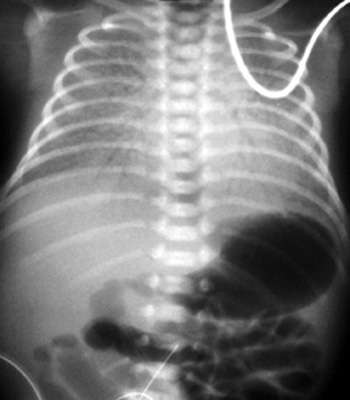Medical Respiratory Neonatal Distress

|
Respiratory Distress Syndrome (RDS)
Respiratory distress syndrome is the term used to describe the clinical manifestations of surfactant deficiency, and it is synonymous with hyaline membrane disease (HMD). RDS is seen in children less than 36 weeks old and is obviously more prevalent and more severe the younger the premature infant. Surfactant production from type 2 pneumatocytes begins at 24 weeks. Surfactant lowers the surface tension of the alveoli, and without it, the alveoli lose their compliance, collapse and have difficulty ventilating. RDS presents immediately at birth with respiratory compromise. Synthetic surfactant is now administered in the delivery room to high-risk infants and has greatly improved the survival of premature infants.
The classic radiographic findings of RDS include diffuse symmetric reticulogranular densities, prominent central air bronchograms and generalized hypoventilation. Neonatal pneumonia can have a similar appearance. The classic findings may not be present because of the early intervention with surfactant and ventilatory support with intubation.
|
| | |
 |
|
CXR in a premature infant prior to intubation with severe hypoventilation, marked air
bronchograms and diffuse symmetric reticulogranular opacities.
|
| |
| | |


![]()
